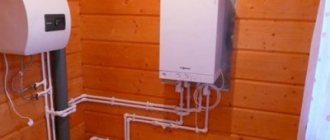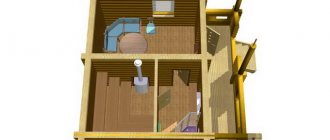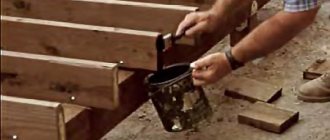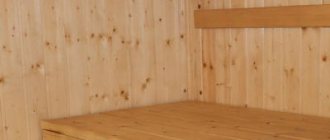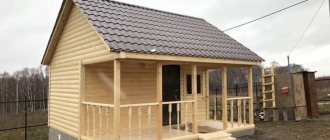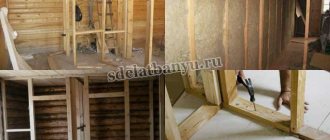When building a wooden bathhouse, you must immediately decide on the need to equip the bathroom. It is most convenient to place it next to the steam room, but for very small buildings there may simply not be free space, in which case the toilet will be located in the house or on the street.
It is not advisable to install a sanitary block next to the steam room if the bathhouse is rarely used or if it has an internal passage into the house. In addition, a full-fledged bathroom cannot be installed in a very small space where there is only room for a steam room and a dressing room.
In other cases, the need for a toilet and shower is quite urgent; a bathroom can be of two types - stationary and mobile. Portable models are compact toilets with biological treatment. They can be used for a bathhouse with a limited area, a specially equipped sewage system and a large space is no longer required. Among the advantages of this type of design, it should be noted:
- there is no need to install water supply and drainage systems;
- a portable septic tank of a compact size is used, which can be placed in any convenient place;
- waste is accumulated in a special bunker with bio-treatment.
The disadvantages include the lack of a shower and more complex maintenance (the waste container must be emptied regularly).
Stationary sanitary units are used if there is sufficient space; there are 3 options:
- Powder closet. Excellent for a small country bathhouse; according to the principle of operation, the design resembles a portable dry closet, but is mounted permanently. A sewer connection is not required; the waste container should be regularly filled with peat or sawdust and cleaned as it is filled. To install such a toilet, good ventilation is necessary to eliminate unpleasant odors.
- Backlash closet. It involves the construction of a cesspool; to clean the septic tank, it is necessary to periodically call sewer trucks, which entails additional costs.
- Classic bathroom with connection to the water supply and sewerage system. This option is suitable for a spacious building; the arrangement will be the most expensive to install. In addition to the closet, you can immediately equip a shower stall or a small swimming pool, if there is free space for this.
Determining the location
Previously, bathhouses were built mainly without a toilet, since the toilet was located in the yard and everyone used it. There were no toilets in the houses either - they considered it something unnecessary. But modern man has become accustomed to comfort in everything and is no longer ready to put up with inconvenience even when visiting his own bathhouse. Therefore, installing a bathroom in a bathhouse is very relevant and in demand. The main nuance in this matter is the fact that the bathhouse, as a rule, is small in size, and it is not easy to allocate a space in it even measuring one meter by one meter.
In addition, the bathhouse is finished with natural wood and the building itself is also often built from wooden logs, so the owners fear that it will be difficult to organize ventilation. After all, wooden surfaces absorb odors very strongly, and the toilet can ruin any vacation. But not everything is so simple here. If you choose the right location for the toilet and comply with all the technology requirements, the result will be quite reliable and acceptable.
So, the toilet must be located so that the entrance to it is not visible from the rest room; it is better to organize such a “nook”. This will not only avoid drawing unnecessary attention to such a delicate issue, but also possible odors will linger. Also, when choosing a place for a toilet, you need to take into account the location of the sewer pipe or septic tank on your site, since you will have to drain the drain exactly there and the shorter the distance, the lower the costs.
It is also worth saying a few words in favor of completely abandoning the toilet in the bathhouse, because such an opinion is quite common and even occurs more often than a decision in favor of comfort. So, a toilet in a bathhouse will lead to the following inconveniences:
- The area of the building will have to be increased or the size of the internal premises reduced.
- You will have to install a separate cesspool or obtain permission to tap into the sewer.
- It will be necessary to supply water to the building and organize its safety in the winter, when the bathhouse is rarely used.
- Purchase of plumbing and finishing costs.
But if all these problems don’t scare you, then let’s move on to the immediate description of the work.
The toilet in the bathhouse should be located so that it does not attract unnecessary attention.
Arrangement of the utility block
The utility block allows you to make a bathhouse not just a bathhouse, but a building where you can also cook food, receive guests, and relax. This allows you to free up a significant part of the residential building and use a separate room for economic purposes.
Of course, the design of a bathhouse with a utility block should differ in the following parameters:
- convenient entrances to the premises;
- good water supply;
- heat exchange networks;
- security measures.
It is worth paying special attention to the last point, since you may need to use both the bathhouse and the utility unit at the same time. Therefore, safety rules must be followed. Good thermal insulation of the room, ventilation system and the use of moisture-resistant materials are also important here.
Water supply
If you have already decided on the location and know exactly where the toilet and plumbing will be located in it, then you need to think about how to supply water to this location. This must be done at a stage when plumbing has not been installed and finishing work has not been carried out. If the bathhouse already has a shower, then the problem is reduced and you will only need to redistribute the water supply from this room. But if there is no water in the bathhouse at all, then there will be more worries.
The first thing that needs to be decided at this stage is how the bathhouse will be used in the winter. If you rarely visit it or it is located in a country house where no one lives, then the water will have to be drained from the system in cold weather. Otherwise, the water in the system will freeze and the entire structure will become unusable. If you don’t want to drain the water, or the bathhouse is located near the house, then you need to think about the heating system. In large baths, which are often used and in which a lot of time is spent, traditionally, a classic heating system is installed.
If there is no heating in your bathhouse, then you can simply insulate the water supply pipes; for this, special insulating sleeves are put on them at the installation stage. They are sold today in any hardware store. Of course, you can wrap the pipes with insulation and fix it, but this is very labor-intensive. In addition, special couplings will not only protect the pipe from freezing, but also prevent the formation of condensation. Therefore, there is no point in experimenting, especially since such couplings are very inexpensive.
It is most convenient to add water to the bathhouse toilet during the construction stage
The installation of a water supply must be approached responsibly and carefully, since the entire operation of the bathhouse will depend on the quality of the water supply. For water supply to the bathhouse, you need to use a plastic pipe with a diameter of 3-4 cm. When purchasing the necessary materials, you also need to purchase plastic corners and fittings that will be needed to connect the system. The plastic water supply system is connected using a special pipe soldering iron, so if you don't have one, it's worth thinking about where to get one.
Shower in the bath
Water can be supplied to the washing compartment of the bathhouse if this room is constantly heated. A heater needs to be installed in the shower room. Only cold water is supplied from the house, and it is heated in the bathhouse itself. Faucets for supplying cold and hot water, as well as shower heads are installed. The result is a modern shower room.
The water can be drained into a crushed stone filter. Since this wastewater contains a small amount of BAC, it is considered “gray”, so you can safely bypass the septic tank. A simple sump will do.
Of course, it is important that the shower room has good thermal insulation and is lined with moisture-resistant materials.
Drain or sewer
Another fundamental point for installing a toilet is draining wastewater, that is, organizing a sewer system. This issue also needs to be resolved at the initial stage, that is, before finishing and installing plumbing. If you have a network sewer system, and you have the right to safely connect to it, then you can consider half the matter solved. You just need to remove the pipe from the bathhouse toilet and connect it to a common sewer pipe. If it is impossible to cut into the general sewer system, then you will have to build a separate cesspool and bring the pipe into it.
If it is possible to connect to the network sewer, then this is very good
In the bathhouse itself, in the toilet, you need to install a pipe to which the toilet will subsequently be connected. To do this, you need to accurately determine its location and prepare the space for work. The fact is that simply running the pipe through a wooden floor will be wrong, as this will create a danger of the floor rotting and the spread of dampness. Therefore, it is better to at least lay the floor in the toilet area with ceramic tiles - make a square of 60 by 60 cm, but it would be more practical to lay the entire floor with tiles. But this is already finishing, and we are talking about drainage.
So, you need to cut a round hole in the floor, the diameter of which should be slightly larger than the diameter of the pipe. Lay a metal mesh on the floor equal in size to the planned tiles (60x60 cm or over the entire floor), the mesh must be shot to the floor with a construction stapler. After this, you need to prepare a concrete solution according to the following formula:
1 part water + 2 parts sand + 1 part cement
You will need a little solution at this stage, so do not overdo it. Now you need to carefully cement the prepared space and let it dry. At the same time, it is necessary to remove the drain pipe and secure it in the hole with a solution, this will ensure the reliability of the structure and prevent the spread of a damp environment. All this work will take about a couple of days to dry. The diameter of the pipe for the sewer outlet is usually 100 mm; this diameter is considered optimal for a toilet. Next, from the bathhouse the pipe is laid directly to the drainage point. If it is a sewer, then the pipe is connected directly to the main line. But if you decide to make a separate pit, then you need to say more about it. To finish the conversation about the pipe, it should be noted that the drain pipe must always run at a slight slope along its entire length. It should be buried approximately 50-60 cm into the ground, depending on the climate in which you live.
It is better not to leave the drained sewer next to the tree, but to concrete the floor around it
Bathhouse with toilet: design nuances
There are many projects of ready-made baths, where the presence of a toilet is provided. But when designing a bathhouse yourself, you should plan the toilet based on the sewer outlet and pay attention to the water outlet. The sanitary room should be located in a secluded area of the bathhouse near the shower or with a sink for washing hands. The project also provides for windows and heating. The room should be equipped with a blind door. When designing a bathhouse with a toilet, you should determine the type of foundation, the name and volume of materials used, the number of floors, the type of floors, roofing, external and internal decoration, and the number of openings.
Construction of a cesspool
If the pit is made only for the bathhouse toilet, then it should not be very large. In this case, a pit with a depth of 2 m and a diameter of approximately 70-80 cm will be sufficient. You may think that this is too much, but believe me, this option will allow you to safely use the toilet without restrictions, and also resort to cleaning the pit as little as possible. In addition, such a pit takes longer to fill and cleans itself faster. The basic principles for creating a cesspool should be listed:
- The edges of the pit must be clearly vertical, this prevents fermentation of waste water.
- The bottom of the pit should be covered with a layer of gravel about 10-15 cm, so the water will drain faster and the pit will not deform.
- The pit must be closed with a special hatch (concrete or metal) with a lid on it. This will allow you to quickly clean it if the pit is full.
When a cesspool is installed for a residential building, concrete rings are installed in it, which ensures its reliability. But for a small pit designed only for a bath toilet, you don’t have to do this - you’ll only end up with significant extra costs. You can strengthen the walls of the pit with car tires. Once again, it is worth recalling that the drain pipe must enter the hole at an angle.
If the pit is made only for a bath toilet, then you can choose the simplest option
Interior decoration
After you have installed water and sewerage into the bathhouse toilet, you can move on to the interior arrangement of this room. You will have to make some purchases for this work and it is better to purchase everything you need at once. So, here is a list of purchases:
- Door to the toilet.
- Toilet and cistern.
- Ceramic tiles for finishing (you must first take measurements from the surface you will be finishing).
- Tile adhesive.
- Hinges and door fittings.
- Accessories for the toilet (hose for water connection, siphon, circle, etc.).
- Household toilet accessories (whisk, toilet paper holder, foot mat).
These will be your main purchases; you can add or remove something from the list at your discretion.
Laying ceramic tiles. Most often, in a finished wooden bathhouse, when installing a toilet, ceramic tiles are laid only on the floor. If you cemented part of the floor when removing the sewer, then the work is simplified. If not, then you need to lay a metal mesh on the floor surface so that it covers exactly the distance that you will be tiling.
Therefore, you need to prepare tile adhesive as indicated on its packaging. The tiles must be laid very carefully and evenly, checking your work with a building level. If you decide to lay tiles only around the toilet, and not along the entire floor, then the edge of the resulting space must be treated with plastic or metal molding, which is laid immediately under the tiles.
Ceramic tiles fit perfectly on a wooden surface
https://www.youtube.com/watch?v=izlONurasco
Toilet installation. As a rule, it does not take much time, the main thing is to do everything carefully and in exact accordance with the instructions included with the plumbing fixtures. The fact is that today there are many models of toilets on sale and different requirements may be imposed on their installation. Therefore, it is necessary to connect the tank to the water supply; to do this, you need to remove a special hose from the tank, which will be connected to the water pipe.
Installing a toilet according to instructions
Door installation. Even at the stage of creating a toilet in the bathhouse, you can install a door, but it is better to do this at the final stage. The fact is that if you lay tiles in the toilet, the door may get dirty during this work. The door must be installed in one day, clearly leveled and the space between the frame and the wall filled with polyurethane foam. After this, the door cannot be touched for about a day - it must dry.
The door must be installed carefully and wait for it to dry completely.
Tags: bathhouse, toilet
« Previous entry
Septic tank and dry closet
Modern offers ordinary people solutions to the most complex issues, including the simple creation of a bathroom. Therefore, if you have no desire to tinker with the pit and everything else, you can purchase a ready-made dry closet, it includes:
- A container with antiseptic liquid that solves the problem of waste disposal.
- Toilet.
- Drainage cistern.
These are the main components of such a system; they can have different configurations and appearance, but their essence is the same. Therefore, many today prefer such simple and practical devices.
Dry toilet in the bathhouse
As for the septic tank, everything is even simpler. Today there are many different options for such devices on sale, you just need to choose what suits you. Basically, septic tanks are distinguished by volume, so choosing is not difficult. The essence of this system is as follows: a septic tank is buried in the ground instead of a cesspool. The septic tank contains a special liquid that allows you to efficiently dispose of all waste. After a certain period of time, the septic tank must be cleaned and this liquid in it must be changed, but the period between replacements is very long.
Using block containers
The use of block containers greatly simplifies the construction of bathhouses with a toilet, shower and utility unit. They include everything you need, including suitable furniture. Block containers for bathhouses are lined with wood inside, and their design corresponds to a classic Russian bathhouse. The entire structure is completely fireproof.
In addition, if necessary, such a bath can be easily transported or moved to another location. All necessary equipment is included in the kit.
Source: stroyvolga.ru
Possible designs
In principle, a toilet in a bathhouse can be of 2 types: mobile (portable) and stationary. If the bathroom is organized in an existing structure, then the first option is more suitable. In a small bathhouse built long ago, all the rooms are clearly laid out according to the required area, where there is no isolated “nook” for the toilet. In this case, lightweight standard partitions are installed and a local container is provided for collecting waste.
For an already built bathhouse without a bathroom, you can use a portable dry toilet, separating it with a partition
A permanent bathroom is included in the construction plan already at the design stage. It has its own permanent walls and door. The sewer drain is formed in advance and ensures the operation of the establishment. The option of an attached stationary toilet is possible, when it is built in close proximity to the bathhouse foundation, and the entrance to it is organized from the bathhouse room.
A stationary toilet must be installed at the bathhouse design stage
Mobile structures include mobile cabins and dry closets. Mobile cabins are made in the form of light partitions, and disposable containers are installed to collect sewage, which are emptied after the bath procedure. One of the common options is a powder closet, or dry toilet. In it, the container is filled with sawdust or peat, which absorb sewage. To clean it outside the bathhouse, a sealed, storage septic tank is built, periodically cleaned by vacuum cleaners. This design does not have a sewer drain, but ventilation must be equipped. For this purpose, a ventilation duct with an exhaust fan is installed. Mobile booths are installed in the dressing room or rest room.
The dry toilet is filled with peat or sawdust
A more expensive, but reliable, modern version of a mobile bathroom is a dry closet. It is a mobile, ready-made stall with a toilet. There is no need to connect sewerage to it, because... Sewage is collected using a two-section container. Sections are arranged vertically. The upper compartment, connected to the toilet and water tank, is equipped with a pump that flushes feces into the lower section.
The lower part with a volume of 10-25 liters is designed to accumulate runoff. This storage tank is equipped with a valve and a pipe for cleaning the container. A chemical-type dry closet uses special reagents that break down solid components and eliminate odors. High-quality dry closets are equipped with tank full indicators. Regardless of the speed of filling the container, the effect of chemical reagents lasts for 12-14 days, after which you will have to clean the container and introduce a new portion of the reagent.
Special reagents are used to care for the dry closet.
The electric dry closet is considered the most effective. It costs more, but does not require the use of chemicals, and the filling cycle lasts much longer. In this design, the lower section is divided into 2 compartments - storage units for the liquid and solid fractions, and drying is carried out in the compartment for collecting solid waste. The liquid fraction, significantly diluted with water, can be sent to the drainage system of the bathhouse.
Electric dry closet diagram
Why problems arise
First of all, you need to decide whether a bathroom is needed in the bathhouse. Maybe it’s easier to run to an existing toilet if necessary? This issue must be resolved taking into account all the features of the bathhouse itself and its comfort.
Advice! If a stationary toilet is located very close to the bathhouse or it is used quite rarely, then it is not advisable to place the bathroom inside. The same can be said if there is a very small bathhouse in which there is no rest room.
In most cases, the need for a toilet inside a bathhouse is quite urgent. As a rule, private areas are fenced off with an openwork or mesh fence, which does not allow you to run to the toilet undressed, and getting dressed and undressing spoils the entire bathing procedure. If the bathhouse is used in the cold season, then it is generally difficult to do without a warm internal toilet, especially during a leisurely process with relaxation in the relaxation room. The relevance of such an institution is dictated by the presence of children. They definitely shouldn’t be allowed out into the street when they’re hot. Finally, the design of a bathhouse with a bathroom is about providing comfort and increasing prestige, when you are not ashamed to invite friends to take a steam bath in the bathhouse.
The bathroom is more suitable for a large bath or sauna with a relaxation room
What is the problem with placing a toilet in a bathhouse? The following circumstances can be highlighted:
- The need for a completely isolated area. Even taking into account the small dimensions of the bathroom, it is quite difficult to find additional space in a small bathhouse.
- Increased requirements for sewerage discharge. While wastewater from a bathhouse can be discharged into the soil through drainage wells, this cannot be done with toilet sewage. Feces must not be collected in pits or transported through chutes. They should be immediately collected in storage tanks or discharged outside through pipes. In this case, hydraulic locks are required that can eliminate odor.
- Ventilation. The role of ventilation is increasing, and in the bathroom it should have a forced exhaust character.
- Isolation. Water vapor should not penetrate into the toilet, which will condense on the structural elements. In addition, increased air temperature is also undesirable, because This all stimulates the spread of odors.
It is necessary to carefully consider the sewerage and drainage system in the bathhouse
Features of stationary structures
A stationary bathroom in a bathhouse can be in the form of a separate isolated room inside the building or a small extension on the outside. This toilet is equipped with permanent sewerage and ventilation.
An attached bathroom can be built simultaneously with the construction of the bathhouse itself. In this case, its foundation becomes a continuation of the bathhouse base, and the entrance is organized from inside the building. If the toilet is attached to an existing facility, then it is built directly next to the foundation of the bathhouse. There are several options for logging in:
- from the inside, when a door is cut through the wall;
- in the vestibule: in order to connect the toilet and the bathhouse, a vestibule (canopy) is also built;
- from the street: the entrance to the toilet is located on the street, but in close proximity to the bathhouse entrance.
Photo 1. Plan of a bathhouse with a toilet indoors Project of a bathhouse with a toilet in the vestibule Project of a wall block with a toilet for the bathhouse
The combination of a bathhouse and a bathroom (photo 1 clearly illustrates it) with its internal placement is included in the construction design. There are many standard projects that allow you to implement such an idea with the optimal location of all departments. The fact is that the toilet is a rather specific room, and it should not disturb the comfort of vacationers.
Important condition! For a toilet in a bathhouse, a stationary sewerage system is required.
It can have several options:
- A separate storage septic tank outside the bathhouse, into which sewage flows through a pipe by gravity. As a rule, it is located near the bath wall, but is isolated and does not emit odors.
- General sewer system. The toilet drain is combined with the bath drain from the steam room and washing compartment if a complete local sewage system with several septic tanks is equipped.
- Cesspool. This option is only suitable for an attached bathroom.
To remove sewage from the bathhouse, you can build a septic tank or cesspool
Another important requirement for a permanent indoor toilet is the availability of water to flush the toilet. The flushing system can be organized in the following ways: central water supply; own water supply from a well or borehole; storage capacity.
A stationary toilet must come with a flush system. Flushing options in the toilet.
Reset organization
Without solving the issue of collecting and disposing of sewage, it is impossible to create a bathroom in a bathhouse. The most reliable and safest in terms of sanitary standards is the construction of stationary septic tanks outside the bathhouse area. They are sealed wells of the required capacity, in which the discharged mass is accumulated and subsequently pumped out by sewer trucks.
In the toilet itself, a standard connection of the toilet bowl to the sewer pipe is provided using standard elements. Next, the pipe is laid in a trench with a slope to ensure gravity flow of liquid (at least 2 mm per meter of length). The depth of its installation must exceed the depth of winter freezing of the soil.
The sewer pipe is connected to a sealed storage tank. A septic tank, as a rule, is made of reinforced concrete well rings with a diameter of 0.9-1.2 m with reliable waterproofing of the joints on the outside. The bottom of the well is filled with concrete 20-30 cm thick and reinforced with steel rods. The top of the septic tank is covered with a concrete slab with a hole for a hatch.
Sewerage diagram for a toilet in a bathhouse with a septic tank and ventilation
When constructing an attached toilet, a cesspool is often used for drainage. The main requirement for it is the tightness of the bottom and walls. It can be made by pouring concrete, from sand-lime brick followed by plaster, in the form of a metal or plastic container. The construction of an attached bathroom begins with digging this hole and arranging it. The advantage of this method is that there is no need to lay sewer pipes.
nuance! When planning storage tanks of any design, it should be remembered that feces tend to decompose, releasing substances harmful to the human body.
To eliminate the risk of poisoning, it is necessary to provide a ventilation duct for the outflow of gases from the storage tanks, and the outlet should be raised above the roof of the bathhouse.
